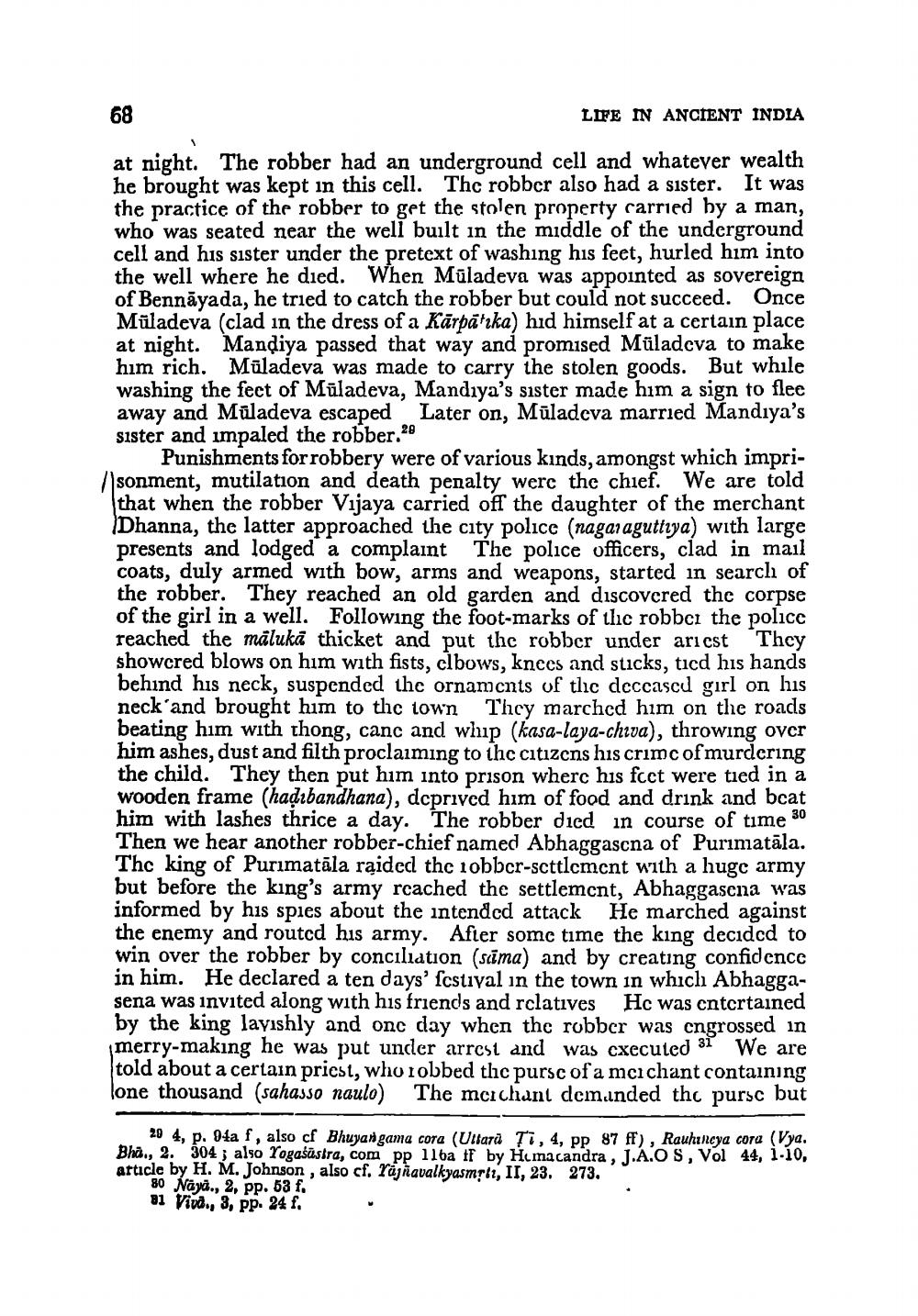________________
68
LIFE IN ANCIENT INDIA
at night. The robber had an underground cell and whatever wealth he brought was kept in this cell. The robber also had a sister. It was the practice of the robber to get the stolen property carried by a man, who was seated near the well built in the middle of the underground cell and his sister under the pretext of washing his feet, hurled him into the well where he died. When Müladeva was appointed as sovereign of Bennayada, he tried to catch the robber but could not succeed. Once Müladeva (clad in the dress of a Kārpārka) hid himself at a certain place at night. Mandiya passed that way and promised Müladeva to make him rich. Muladeva was made to carry the stolen goods. But while washing the feet of Muladeva, Mandiya's sister made him a sign to flee away and Muladeva escaped Later on, Müladeva married Mandiya's sister and impaled the robber.20
Punishments for robbery were of various kinds, amongst which imprisonment, mutilation and death penalty were the chief. We are told that when the robber Vijaya carried off the daughter of the merchant Dhanna, the latter approached the city police (naganaguttiya) with large presents and lodged a complaint The police officers, clad in mail coats, duly armed with bow, arms and weapons, started in search of the robber. They reached an old garden and discovered the corpse of the girl in a well. Following the foot-marks of the robber the police reached the mäluka thicket and put the robber under ariest They showered blows on him with fists, elbows, knees and sticks, tied his hands behind his neck, suspended the ornaments of the deceased girl on his neck and brought him to the town They marched him on the roads beating him with thong, canc and whip (kasa-laya-chuva), throwing over him ashes, dust and filth proclaiming to the citizens his crime of murdering the child. They then put him into prison where his fcct were tied in a wooden frame (haḍibandhana), deprived him of food and drink and beat him with lashes thrice a day. The robber died in course of time Then we hear another robber-chief named Abhaggascna of Purimatāla. The king of Purimatāla raided the 10bber-settlement with a huge army but before the king's army reached the settlement, Abhaggasena was informed by his spies about the intended attack He marched against the enemy and routed his army. After some time the king decided to win over the robber by conciliation (sama) and by creating confidence in him. He declared a ten days' festival in the town in which Abhaggasena was invited along with his friends and relatives He was entertained by the king lavishly and one day when the robber was engrossed in merry-making he was put under arrest and was executed We are told about a certain priest, who robbed the purse of a mei chant containing lone thousand (sahasso naulo) The merchant demanded the purse but
30
20 4, p. 94a f, also cf Bhuyangama cora (Uttara Ti, 4, pp 87 ff), Rauhneya cora (Vya. Bha., 2. 304; also Yogasüstra, com pp 116a ff by Hemacandra, J.A.O S, Vol 44, 1-10, article by H. M. Johnson, also cf. Yajnavalkyasmṛti, II, 23. 273.
80 Naya., 2, pp. 53 f. 81 Viva., 3, pp. 24 f.




